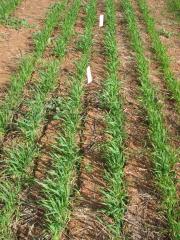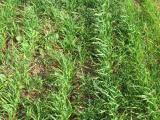Chemical control
Even though some brome grass populations in WA have evolved resistance to some Group 1, 2 and 9 herbicides, a range of pre-seeding and in-crop selective herbicides are now available to control this weed (Table 2). Brome grass is more effectively controlled in broadleaf crops or in pastures than in cereal crops. On the average, brome grass seed bank life is about three years. In a non-wetting soil, seed of brome grass will survive from a break crop (canola or lupins) to subsequent cereal crop despite all control measures in the break crop.
Crop topping by glyphosate in wheat, chickpea, lentils, faba beans and field peas may reduce brome grass seed set. Timing is the main issue to consider when thinking about crop-topping, particularly if brome grass is the target. Brome grass matures a lot quicker than some crops and will set seed before the crop can be legally sprayed. Lentils, field peas and lupins generally mature early enough to kill many grass weeds by crop topping. To reduce brome grass seed set by crop-topping, it is essential that an early maturing crop variety is selected and the crop is sown early so that weeds can be targeted before they have an opportunity to set seed and withholding periods are avoided.
| Herbicide group | Herbicides for crops | Herbicides for pastures |
|---|---|---|
| 1 | Butroxydim, clethodim, fluazifop, haloxyfop, propaquizalofop, quizalofop-p-methyl, sethoxydim, tepraloxydim | Butroxydim + fluazifop-p-butly, fluazifop-p-butly, haloxyfop, propaquizalofop, quizalofop-p-methyl, sethoxydim, tepraloxydim |
| 2 | Chlorsulfuron, imazamox, imazapic + imazapyr, imazapic + imazamox, mesosulfuron-methyl, sulfosulfuron, pyroxsulam | Imazamox |
| 5 | Atrazine, cyanazine, diuron, metribuzin, simazine | - |
| 3 | Trifluralin | Propyzamide |
| 5 + 3 | Metribuzine + trifluralin | - |
| 15 | Prosulfocarb + s-metalochlor | - |
| 3 + 15 | Trifluralin + prosulfocarb + s-metalochlor | - |
| 2 + 4 | Imazapic + imazapyr + MCPA | - |
| 15 | Pyroxasulfone | - |
| 22 | Paraquat + diquat | Paraquat, diquat, paraquat + diquat |
| 9 | Glyphosate | Glyphosate |
While trifluralin can suppress brome grass, herbicides such as prosulfocarb + s-metolachlor (for example, Boxer Gold®) at pre-sowing and pyroxsulam (for example, Crusader®) at post-emergence may be more effective on brome grass in wheat crops.

An untreated wheat plot is shown in the top image and a plot treated with prosulfocarb is shown in the bottom image.

